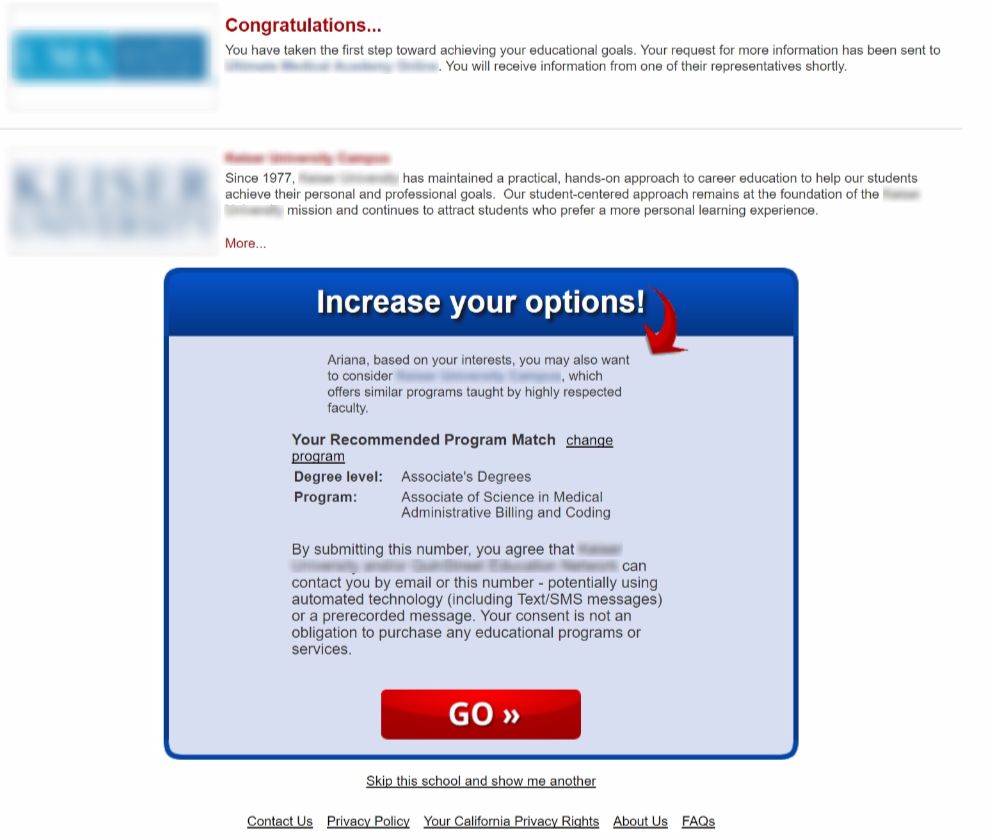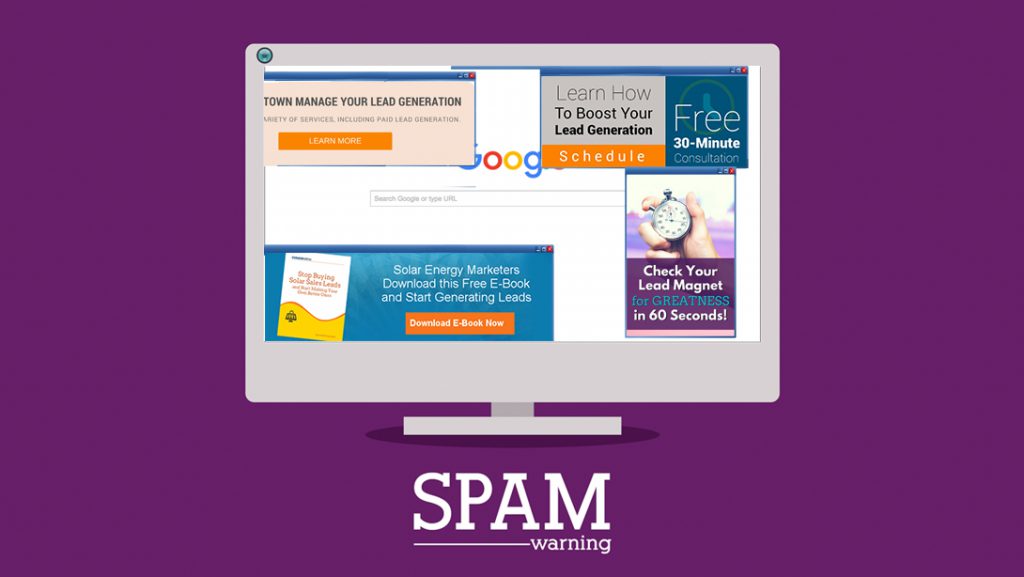I’m not sure when lead vendors surfaced in the educational vertical. Was it before or after insurance and mortgage? Or was it around the same time when “credit repair” and “work from home” offers started surfacing. Maybe it was in the late ‘90s after Google and search engines gained traction. At any rate, their inception and early years aren’t important. It’s what they do today that bothers me. And apparently I’m not the only one who is troubled by lead vendors, as both the Federal Trade Commission and Consumer Finance Protection Bureau along with state regulators have started watching their activities. And last year the Department of Education issued warnings reminding lead-generation firms that they cannot use Department logos.
In similar fashion, Veterans Education Success has published a lengthy report in an effort to help veterans “understand misleading websites and lead generators.”
I wonder if 2000+ Leads Con attendees in New York last week even know what goes on?
Even more recently, an article published at Inside Higher Ed examined the increasing use of “secret shoppers” to review the performance and practices of third-party lead vendors. At Norton Norris, we’ve been a national leader in providing mystery shopping and assessment services to schools across the country for more than 20 years.
And, how do I know the real truth? Good question. I own and operate a mystery shopping firm – and we shop lead vendors. I bet that after reading this blog you’ll want to shop your vendors, or you may just want to stop using lead vendors altogether.
Why Pay Per Lead (PPLs)?
For the uninformed reader, here’s how it works: Lead vendors sell inquiries to schools on a pay-for-performance model. Over the past several years many schools abandoned their traditional advertising (TV, radio, outdoor) and moved to the lead-vendor diet. Although contact rates are low – normally under 50 percent – and the conversions from inquiry to new student are abysmally low and average just 2 or 3 percent at most institutions, the attractive feature of scalability and paying only for what you get hooked many schools. At first it was just another tool in the marketing toolbox. But then the savvy operators discovered that coupling a call center with pay per leads (PPLs) would yield predictable numbers that could be “modeled” and the race was on. Once they perfected the model they could add more PPLs to the mix, increase call center staffing and grow enrollments – especially in the online learning environment. It was magic. But many enrollment managers never knew what was really happening. And they still don’t.
How it works for a prospective student
From the student’s perspective, using an education matching system could seem like a good idea. I mean, if you aren’t sure where you want to attend but you know you want to pursue  additional training, then browsing the web and finding a solution that matches you to schools – or lets you pick from a few select schools might make sense. And that’s how many of these services work – or are supposed to work.
additional training, then browsing the web and finding a solution that matches you to schools – or lets you pick from a few select schools might make sense. And that’s how many of these services work – or are supposed to work.
The prospective student often begins their inquiry journey by simply entering their zip code in response to the offer to “find schools in your area.” The less scrupulous vendors may be trolling with a scholarship or sweepstakes offer – but we’ll talk about that later. After entering their zip code and/or address, the prospective student is taken through a few questions:
- What level of degree or training are you looking for (certificate/diploma, associate degree, bachelor’s degree, master’s degree)?
- When would you like to begin education/training (immediately, 1 to 3 months, 4 to 6 months, etc.)?
- What is your highest level of previous education?
The slick sites always insert some sort of teaser along the way… “just 2 more questions and we’ll match you with schools that meet your needs.”
- What areas are you interested in (health/medical, business, criminal justice, information technology, graphic arts, welding, etc.,)?
- How would you like to study (online or on ground)?

And then “poof!” after hitting submit, the website reveals schools that are a match. It sounds logical and makes sense. Or does it? You see, the search engine driving the selection of schools isn’t a search engine at all. The website isn’t selecting from the universe of schools at all. Instead it’s serving up suggestions of schools that have contracted for leads. So the listing isn’t inclusive. It’s limited to a short list of institutions that have agreed to buy inquiries. But how would the student know that? They wouldn’t. And that’s just one problem with this product line.
But there is one more wrinkle. It sounds innocent enough too, and even well intentioned. After the student selects a school from the list to learn more about and hits “submit”, the next screen is typically something to the effect of: “Vince, students who research and inquire to more than one school make better and more informed decisions. We’ve also matched you with these schools in your area or that offer online instruction. You may also get information from them by clicking “yes” below.”
And then it happens. The poor prospective student’s phone implodes under the duress of multiple and incessant calls. Under the scenario outlined above, the lead has now been sold to multiple schools. And they all have the same intention: Call immediately and get this student in for a campus visit – or, if it’s an online school, get them on a phone interview ASAP and get them committed to completing an application.
How the Enrollment Managers and Marketing Managers at Colleges See the Process
Unfortunately, many schools that are buying leads from lead vendors are naïve and uninformed as to how the inquiries are really being generated. Because the inquiry comes in via a form that is emailed to the school or posted into their CRM, the school officials believe that the inquiry was submitted by the student, like the scenario described above. Sometimes this is true, as prospective students complete the process explained earlier. But sadly, over half of the inquiries that schools are buying don’t come from a student completing a form. Nope. The inquiries come from a call center.
Here’s how: The lead aggregators contract with downstream affiliates to generate leads. These affiliates buy data that resemble potential students based on socio-economic factors. Then the data goes into an auto dialer at a call center, and when the potential prospect answers, they are talking with a call center agent. The pitch can vary, but often it centers around a training opportunity, a job opportunity, or financial aid to go to school. If a positive response is received, the call center agent – not the student – completes the form and hits submit.
As a side note, if you are a college administrator and considering buying leads from a vendor, ask the vendor for costs and counts based on your programs of study for exclusive, non-call center leads. The response you get could be interesting and range from “we don’t do exclusive leads” to “let me check and get back with you” – but I know the cost per lead will increase.
Okay, back to the real story – what happens when we shop lead vendors. These results are based on a sample size of 100 shops spread across 20 vendors. The school we shopped offered online courses, so the geography was unlimited. The degree level was associate degree.
Problem 1: 40 percent of the lead vendor inquiries submitted were never delivered to the school.
Ouch. Think about the student’s perspective on this. They took time to research schools, found a program and school they were interested in, completed a form, hit submit, got a message back that the school would contact them – and then radio silence. No call back. No email from the school. Nothing.
How could this happen? Well, that’s easy…. If a lead vendor has reached their cap, and the school didn’t have budget for any more leads, then the lead would either go into a black hole, or worse yet – be sold to another school. Both of these options are terrible, but they continue month after month, in our shopping.
Problem 2: 10 percent of the lead vendor inquiries were told that school X wasn’t accepting inquiries.
Wow. What would you think if you were the student? Worse yet, if you are in charge of enrollment or marketing at a school – your lead vendor has just told a prospect that you basically aren’t enrolling. Really? Wait; it gets better.
Problem 3: 10 percent of “your” lead vendor inquiries were referred to another school.
Unbelievable. As an enrollment or marketing manager, I would be furious. And it continues. Each month we inquire about school X – only to be directed via the computer and even by call center reps, that we could inquire to school Y. To me, it’s worse than #2 above – it’s one thing to say a school isn’t taking inquiries, but it’s worse to blatantly direct them to a competitor. Not good. NOTE THAT BOTH SCHOOLS OFFERED THE SAME PROGRAM. And, it gets worse. One of our inquiries specifically made for school “X” was contacted by the lead vendor’s call center and then warm transferred to school “Y.”
Problem 4: Immediate re-sale of data
15 percent of our inquiries immediately got a call from another party other than the school they submitted their information too. How ironic, right? You request information from school “A” and kaboom – you immediately get calls from school “B” or from an-unrelated entity like “Rewards Redemption.” I got a call from XXX-XXX-1234, which was from Julie at Rewards Redemption. The recording stated that I recently was on one of their affiliated websites and I had won a $100 voucher that could be used at popular stores like Walmart, etc.
Final Thoughts and Recommendations
- Shop your lead vendors to keep them honest.
- If lead vendors must be part of your mix, manage them diligently.
- Track the number of voice to voice calls you have with the inquiries from each vendor – remember, if you never talk to the prospect you can’t invalidate them or begin the recruitment process.
- Consider asking your lead vendor for exclusive, non-call center leads.
- Ask your lead vendor to explain and detail how many inquiries come from:
- Student-generated from submissions
- Call centers
- Warm transfers
Finally, consider going to a marketing mix that uses traditional media to drive traffic to your digital properties. A well-balanced advertising mix will fuel your organic website inquiries and your PPC inquiries. Changing the mix of leads will result in driving up contact rates, with a smaller staff. Ultimately you’ll increase enrollments and reduce cost.
More details on : Our Admission Training Program
About Vince Norton
Managing Partner, Norton|Norris, Inc.
Since 1979, Vince Norton has worked in higher education administration, marketing, admissions, and enrollment management, for both not-for-profit and proprietary institutions. His 35-plus years of experience include 19 years in admissions, marketing, and administration at non-profit colleges, and three years with for-profit colleges. For the last 16 years, he has served as Managing Partner of Norton|Norris, Inc. Vince is regarded as an expert on college marketing and mystery shopping and has delivered presentations on this topic for numerous associations.



Leave A Comment